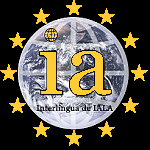| Row # |
Title |
Image |
Description |
| 1 |
Esperanto |
 |
Esperanto was created by Ludwik Lazarus Zamenhof in 1887. The phonology, grammar, vocabulary, and semantics of Esperanto are based on Indo-European languages spoken in Europe. Its sound inventory is essentially Slavic, and so are much of its semantics. The vocabulary derives primarily from the Romance languages, partially from Germanic languages, and has some minor contributions from Slavic languages and Greek. |
| 2 |
Ido
|
 |
Ido was created in 1907 in an attempt to reform perceived flaws in Esperanto.
|
| 3 |
Interlingua
|
 |
Interlingua is modernised version of Latin, and was developed between 1937 and 1951 by the International Auxiliary Language Association (IALA).
|
| 4 |
Novial
|
 |
Novial was introduced in 1928 and devised by Otto Jespersen. Novial's vocabulary is based largely on Germanic and Romance languages, with its grammar having been influenced by English.
|
| 5 |
Occidental / Interlingue
|
 |
Occidental (which was later called Interlingue) was created by Edgar de Wahl and introduced in 1922. Its vocabulary was based on pre-existing international words.
|
| 6 |
Elefen (Lingua Franca Nova)
|
 |
Elefen (or Lingua Franca Nova (LFN)) is a constructed auxiliary language created by C. George Boeree, and introduced via the world wide web in 1998. Its vocabulary is based on the Romance languages: French, Italian, Portuguese, Spanish, and Catalan. Its grammar is highly reduced and is similar the Romance creoles.
|
| 7 |
Communicationssprache
|
|
Communicationssprache was created by Joseph Schipfer and introduced in 1839. Most of its vocabulary and grammar was derived from French, with some influence from Latin, English, and German.
|
| 8 |
Universalglot
|
|
Universalglot is regarded as being the first complete auxiliary-language system based on common elements of national languages. It was developed almost 20 years before Esperanto.
|
| 9 |
Volapük
|
 |
Volapük was developed from 1879 to 1880 by Johann Martin Schleyer. The vocabulary was derived mostly from English, with some German and French.
|
| 10 |
Spokil
|
 |
Spokil was created by Adolphe Nicolas and introduced in 1904. It is regarded by some to be a priori / a posteriori hybrid language.
|
| 11 |
Mundolinco
|
|
Mundolinco was created by J. Braakman in 1888, and was likely the first Esperantido (Esperanto derivative).
|
| 12 |
Bolak
|
 |
Bolak is a constructed language that was created by Léon Bollack and introduced in 1899. It had a mix of a priori and a posteriori elements, with the latter being derived from Romance and Germanic languages (for the vocabulary) and phonology from French.
|
| 13 |
Idiom Neutral
|
|
Idiom Neutral is an international auxiliary language that was published in 1902 by the International Academy of the Universal Language. It was developed from a heavily revised form of Volapük.
|
| 14 |
Latino sine Flexione
|
|
Latino sine flexione is an international auxiliary language that was created by Giuseppe Peano in 1903. It was based on Latin, but influenced by ideas from other auxiliary languages.
|
| 15 |
Neo
|
 |
Neo is an artificially constructed international auxiliary language developed by Arturo Alfandari and introduced in 1961. Most of its vocabulary was derived from Romance languages, and with some derived from Germanic languages. Its phonology is based on that of Romance and Slavic languages.
|
| 16 |
Uropi |
 |
Uropi is a constructed language by Joël Landais from 1986. It is based on Indo-European languages. |


















